Bonded by Friendship & Film: Hiro Murai and Larkin Seiple
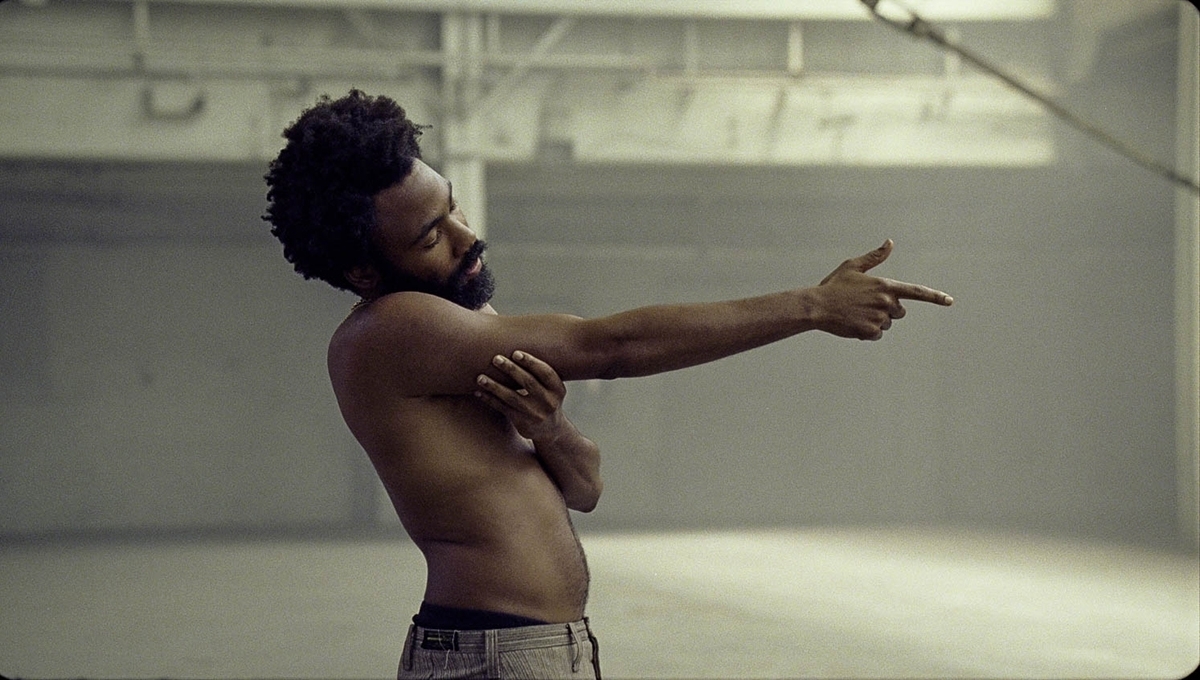
Hiro Murai loves the lighting on Donald Glover and how the background went from chaotic to quiet in this image from "This is America." Image courtesy of Hiro Murai.
The longstanding creative partnership between filmmaker Hiro Murai (Guava Island) and cinematographer Larkin Seiple (Luce) has included the music video “This Is America” by Childish Gambino (Donald Glover) and the Powerbeats Pro ad titled “Unleashed,” both of which were captured on film.
“I was never a very good cinematographer because I didn’t have the details down but had big picture ideas of what I wanted to accomplish,” remarks Murai. “When I work with guys like Larkin, I come into it with broad ideas about the feelings [I want to convey] and have reference points. I know enough about cinematography to be able to explain my ideas to him. I mostly come in from an abstract point of view.”
Larkin views Murai as a good friend. “Anytime you get to work with someone that you’re friends with outside of set is great,” believes Larkin. “You get a better final product because you push each other and also like to raise the stakes and do something different than you’ve done before. Hiro has a specific eye, which is rare and unique. He likes to find ways to frame things that aren’t obvious or also minimalize the subject so you have to focus on what they’re doing.”
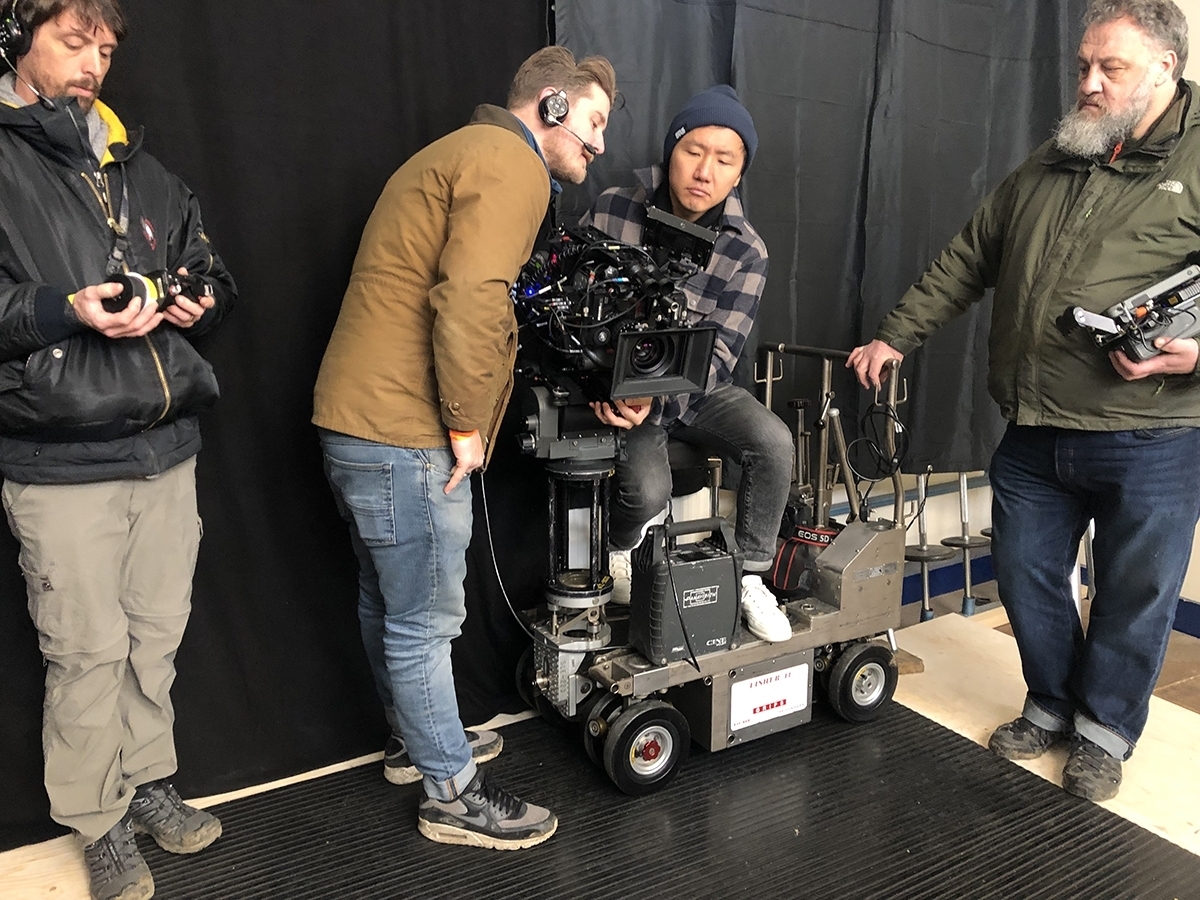
Matt Sanderson 1st AC on the left. Larkin Seiple and Hiro Murai looking at the camera in the middle. To the right is UK Key Grip Pete Nash. Image courtesy of Hiro Murai.
“What drew me towards filmmaking was the allure of film-craft and the sorcery of lighting,” explains Seiple. “When DP’s all shot on film, our input was more coveted in terms of what we had to say and the time you were given to light a scene was taken more into consideration. Now digital has somewhat cheapened that relationship. People see an image and think that they can shoot.” A particular technical innovation could help in making film the medium of choice. “One of the big game changers for film are the new HD video taps coming out for film cameras; the image looks wonderful on set and will make convincing clients to go along with the process easier because they will have a better idea of what is being recorded.”
Murai always wanted to be a filmmaker. “Even back in middle school I was making short films in my backyard.” The career path was not entirely linear. “I found film school suffocating and music videos felt like an irreverent carefree space. People were doing things that resonated with me at the time.”
There is a chaos element to film that Murai finds to be attractive. “It feels fragile. Even when we’re shooting digital, we do all of the things to make it feel less pristine and too clear; whether it’s cranking up the ISO or doing a film out process where the digital footage is scanned onto film. Because of these 4K and 8K cameras, the trend is to zoom in on the clarity, but I always like having a part of an image obscured. The joy of film is that you get to fill in the blanks. Film as an aesthetic is something that I like. I’ve grown up with film and have always romanticized it.”
There is also different atmosphere when a reel is loaded into a camera. “When people talk about film rolling onset everybody’s posture changes. There is more tension in a good way,” Murai says.
“On film, skin tones always feel richer with a greater range of color. It never feels the same on digital,” notes Seiple. “Specifically, darker skin tones tend to patina when underexposed on digital, but on film it feels like there is still a range of color.”
The film stock of choice is KODAK VISION3 500T Color Negative Film 5219/7219. “I’ve tried every other stock and unless I’m doing dramatic effects in the process, like pulling or pushing, I generally stick with 500T because it has a great range and I don’t need as many lights. I also love the texture of it. The grain looks wonderful. I would hate to shoot film and have it without any grain. I remember Roger Deakins ASC, CBE talking about shooting No Country for Old Men entirely with 500T as it worked for both his day and night work. Digital cameras now are in such high ISOs that 500 feels slow for what most people are working with and what most producers budget for. For me, 500 is the magic spot. You can push 500 a stop to get to 1000 and it still looks great.”
A certain aesthetic was needed for “This is America.” “The choice of film was an attempt to make it feel not modern but displaced in time,” remarks Murai who shot the music video in an old Firestone factory situated in South Los Angeles. “The space was leading our choices. We controlled what naturally came in and out and picked the right time of day for the sunlight to come through the windows at the correct angle.”
The shadows needed to be lit. “We would pick blocks where we were getting more backlight and bounce from the windows,” explains Seiple. “The only real lighting that we did were these rows of Sputnik lights for some fake fires. In the basement we used a little reflective light on the chest of Donald Glover for the final shot of him running.”
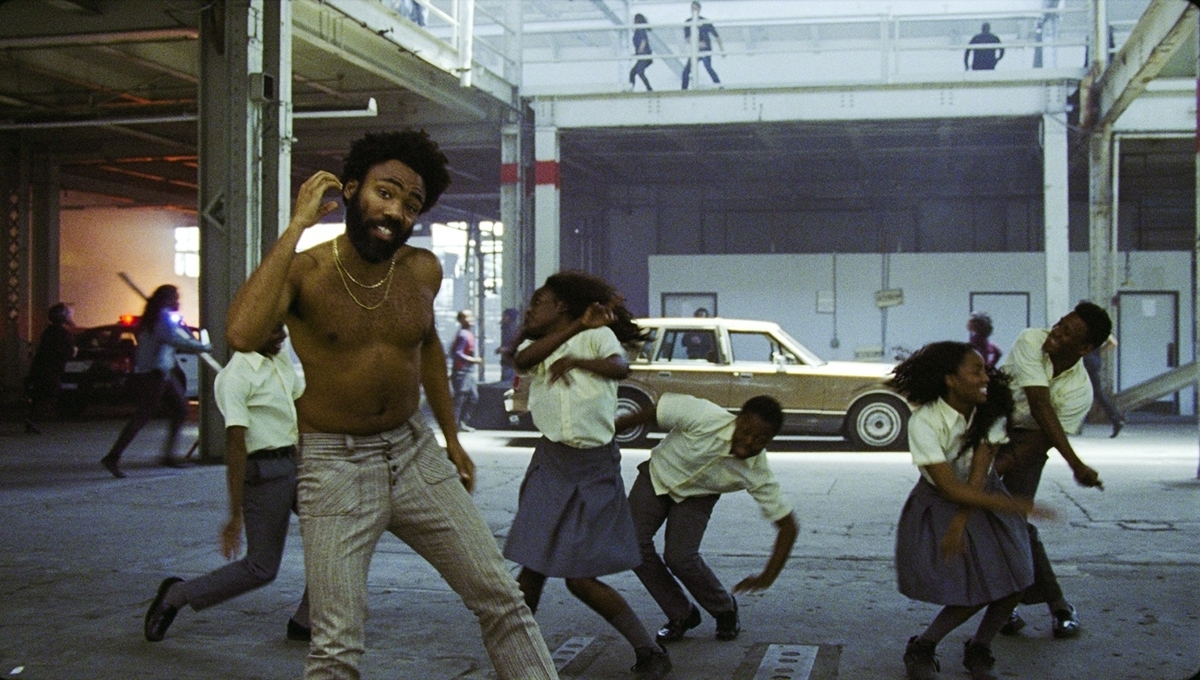
"This is America” consists of six long shots that were extensively choreographed and captured over a two-week period. Image courtesy of Hiro Murai.
Advance planning involved utilizing iPhones. “Larkin and I played the music and rehearsed with our iPhones,” reveals Murai. “But sometimes you don’t know what it’s going to be like until you have 300 people in a warehouse running around and you’re actually shooting on the camera you’re going to shoot.”
The entire production was captured with a single Arricam Studio supplied by Keslow Camera and was paired with Zeiss Super Speed lenses (35mm was favored) and Angénieux EZ-1 zoom 30 to 90mm. “We had to shoot 60 frames per second, so we opted for the Studio over the LT, which is a beautifully made camera,” notes Seiple.
All the scene transitions were figured out ahead of time. “We mapped out in total six shots. Some were long and involved with hundreds of extras while others were simpler where it’s just a choir. Hiro is a big fan of the sustained shot and not cutting; he likes to let people fall into a scene and think about it as supposed to pushing images quickly into your face.”
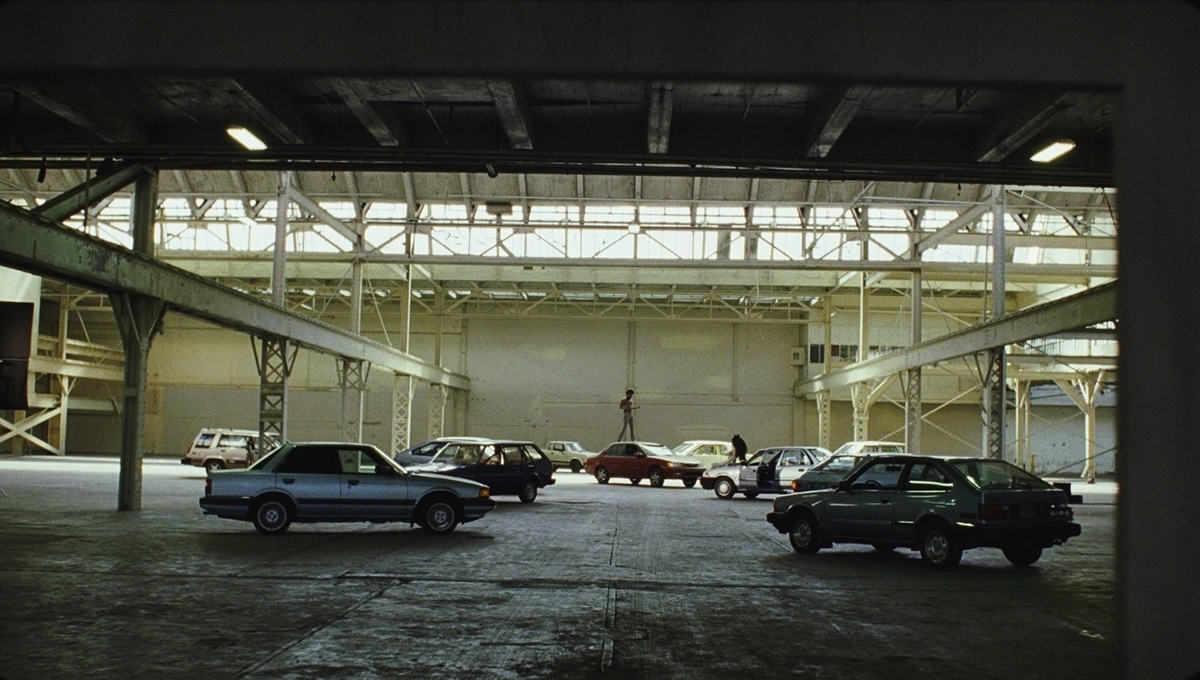
Because of the massive setting of the Firestone Factory the crew of "This is America" organized the shots around position of the sun. Image courtesy of Hiro Murai.
A particular aspect ratio is favored by the duo. “Larkin and I shoot a lot of 4:3 and 16:9,” states Murai. “We haven’t strayed outside of that aspect ratio too much. It depends on the project. I like using the entire screen but there’s also something matter of fact and not pretentious about 4:3 and 16:9 that I like.”
“‘This is America’ was supposed to feel timeless, like an installation piece with natural lighting,” notes Seiple. “It exists. We wanted the camera to be constantly drifting. Not to have it locked down on dolly but more floating and keeping the audience on their toes.”
A particular moment required extensive rehearsals. “We’re wrapping 360 degrees around Donald to reveal a world on fire with hundreds of extras in a riot, a man jumping off a ledge, a white horse riding by a car on fire and ending with a single shot of him where everyone is gone. It took us six hours to choreograph and shoot; and it’s only a 30 second shot!”
The time factor was the most difficult part for Murai. “We were just finishing up the second season of Atlanta when Donald came to me with the idea of doing the video and he had to leave on tour soon after. We had this two-week period from production to execution. It was a tight prep time to choreograph a video and stage these big set pieces. We were running around like a chicken with its head cut off!” Murai adds, “Towards the end when Donald has his hand out like he’s holding a gun and all of the kids disperse, I always wanted that image to land as an iconic portrait and loved how the light fell on him and the background, and how it went from a chaotic environment to quiet; that worked out in a lovely way.”

A shot of British boxer Anthony Joshua in “Unleashed.” Image courtesy of Hiro Murai.
Unlike the prominence of wide shots in “This is America,” close-ups of celebrity athletes Alex Morgan, Anthony Joshua, Ben Simmons, Eden Hazard, LeBron James, Leticia Bufoni, Miho Nonaka, Odell Beckham Jr., Ramla Ali, Serena Williams, Shaun White, and Simone Biles dominate the Powerbeats ad titled “Unleashed.”
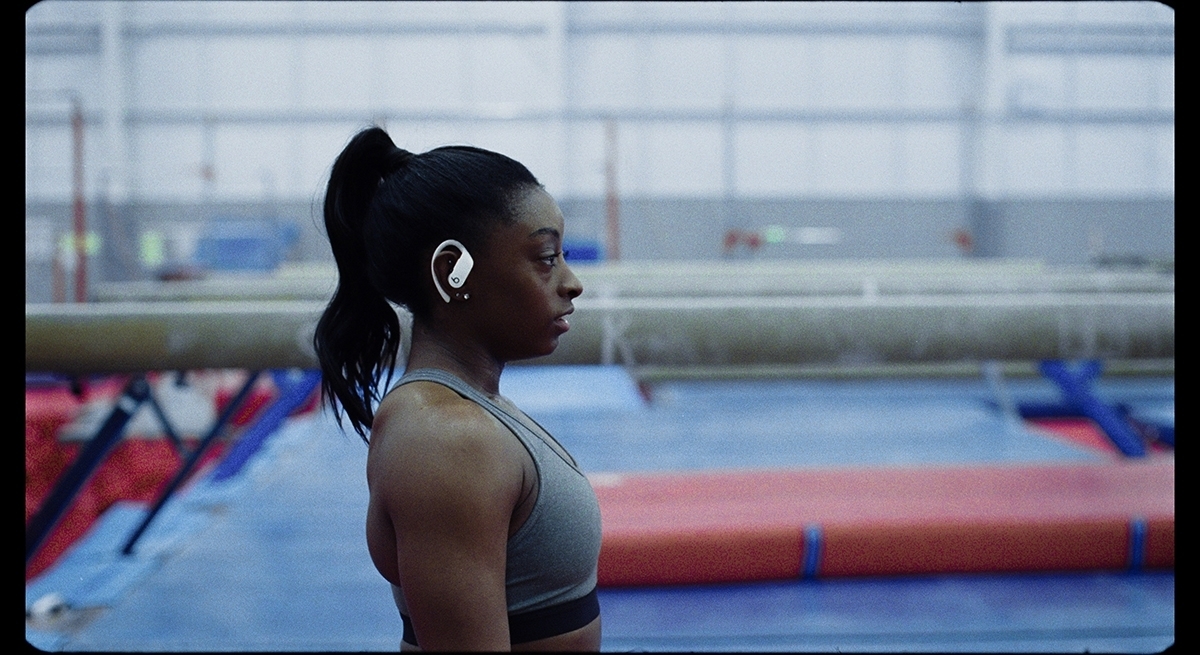
The opening “Unleashed” shot of American gymnast Simone Biles. Image courtesy of Hiro Murai.
“We generally had 30 to 45 minutes with the athletes, so we shot on the Angénieux EZ-1 zoom 30 to 90mm,” explains Seiple. “You didn’t want to be so tight that the background is mush. We wanted to be wide enough to feel where they were and appreciate the effect of the camera tracking.”
There is also an air of mystery. “The whole idea was that you never got to fully see what these athletes were doing,” remarks Murai. “It was usually implied. A barbell would drop into frame. But a lot of the time you didn’t understand the context of it. We approached that whole project as if we were shooting portraits of people’s faces and don’t necessarily see the action they’re performing.”
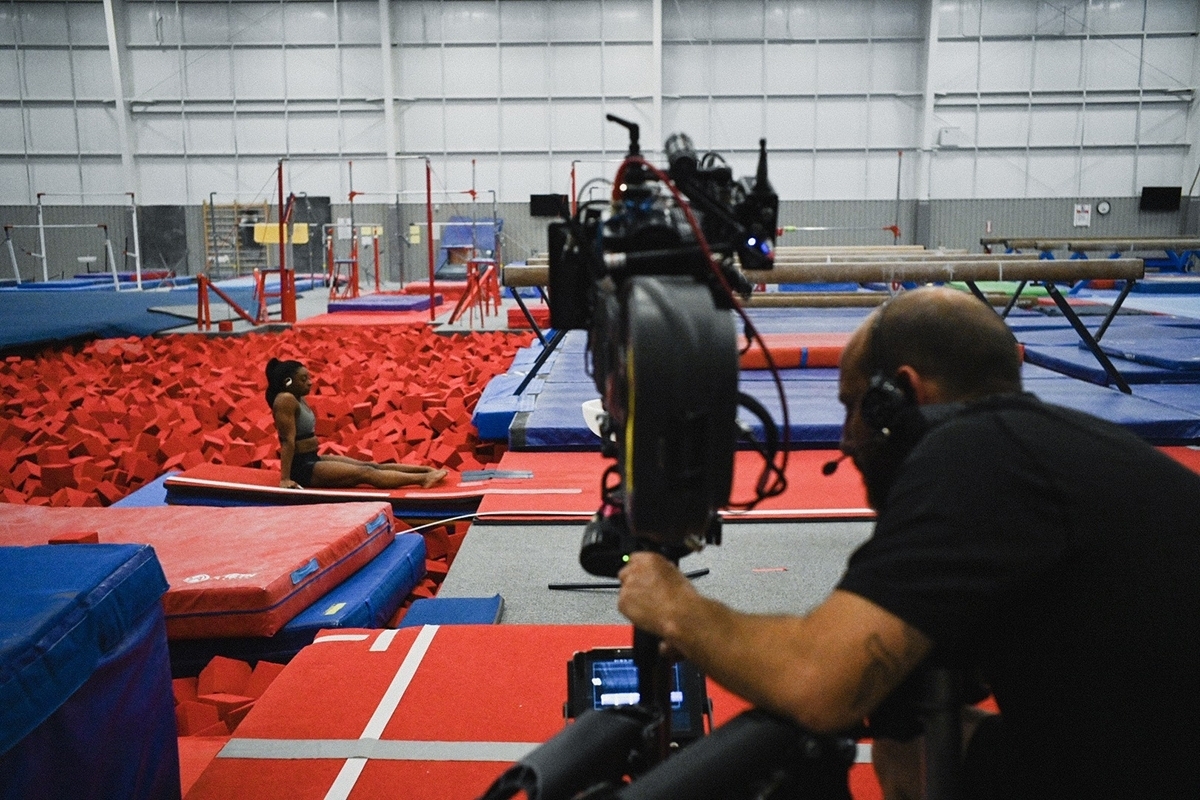
Ari Robbins is holding the Steadicam in the gymnastics center. Image courtesy of Hiro Murai.
The locked camera approach, which synchronized the actions of the different athletes, originated with the ad agency Zambezi. “They had stabilized all of this footage of athletes on this rip reel,” states Murai. “We fleshed out the idea with them and blended five different styles to make a single look. It was a big thing to convince world class athletes to strap a camera onto their body and run around. Even when augmenting digitally, we made sure that the footage was outputted to film for the grain so it didn’t feel too digital.”
They spent an entire day at Keslow Camera doing tests. “We brought out different athletes, trampolines, skateboarders and jibs in order to figure out the best way to mimic the movement of the athletes,” reveals Seiple. “If someone was jumping up, then the camera operator would be jumping next to them or tilting up. Then we tried doggie cams as well, which is like a vest with rods that connect to a plate that you can mount the camera to, but those were used minimally. Those were shot with a Blackmagic. Our biggest test was to see what we could do with film. We realized as long as the camera movement was in sync with the actors, it was going to work out.”

British boxer Anthony Joshua takes a break while shooting “Unleashed.” Image courtesy of Hiro Murai.
“We were probably on and off filming for a month and a half,” notes Murai. “Because of athletes’ availability and getting access to good locations, we shot maybe eight or nine days. Some athletes were only available in this area of town at this time. It was adapting to what was available to us and how to change it, so it could be what we wanted it to be. It was a crazy process.”
ARRI SkyPanels came in handy considering the limited amount of time available for pre-lighting. “We used a couple of bigger 18Ks for some of the darker locations but overall we tried to let it be natural,” states Seiple. “That’s what I love about film is you can point a camera anywhere and it generally looks interesting. The challenge in lighting it was trying to augment any practicals that were available. Some spaces had great light. Like the gymnastics center had plenty of light for us to use. But some of the boxing gyms were darker and moodier, so we had to subtly augment the lighting around the actors so it would be brighter and shoot a deeper stop.”
The majority was shot with KODAK VISION3 500T Color Negative Film 5219/7219 and an Arricam LT camera. “Our goal was to get everything on 35mm 3 perf; however, we realized that 4 perf would be better because the up and down head movement became the biggest challenge to try to track,” remarks Seiple. “We shot film in Houston, Los Angeles, Miami, and London. Occasionally, with complicated shots we would use an ALEXA or RED because we needed more resolution as the movement was too dramatic.”
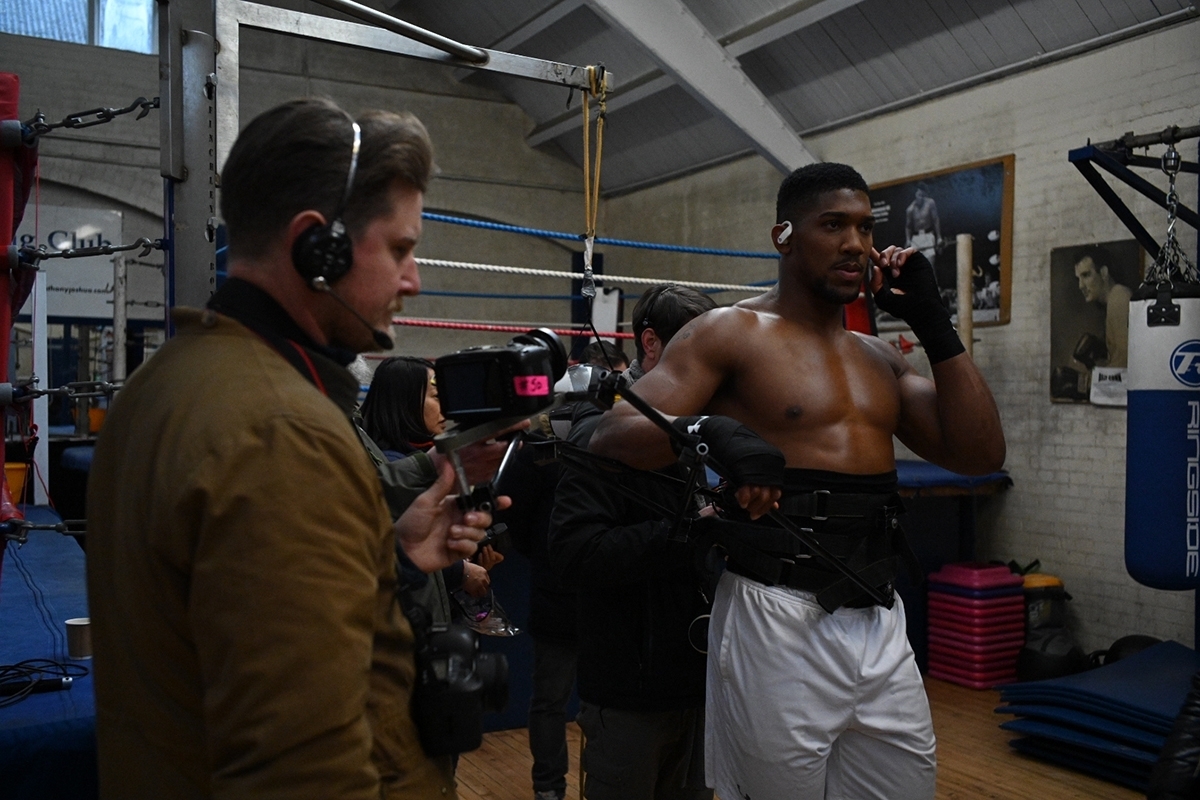
Larkin Seiple is holding the Blackmagic camera rigged to British boxer Anthony Joshua. Image courtesy of Hiro Murai.
The color depth on the film was part of the reason why the ad was not shot primarily digitally. “In numerous situations we didn’t have a lot of control over the environments because these were actual places the athletes rehearse and practice in,” states Murai. “Film was an attempt to get as much color latitude as possible to play with later. Also, aesthetically we didn’t want it to be too stylized and lofty. We were looking for a raw matter of fact type of feel. Film has a lovely way of capturing natural faces without it feeling too controlled.”
“Unleashed” evolved in postproduction with frequent collaborator editor Luke Lynch. “We shot a bunch of stuff and had some idea of what it was going to look like, but the real meat of the footage didn’t show itself until we put it through the visual effects and had it tracked,” explains Murai. “It completely changed the feeling of the footage.”
The decision to have the visuals paired with the song “Saw Lightning” by Beck was made late into the postproduction process. “It’s a complicated thing picking music for a headphone commercial; their brand is tied to a lot of different types of music and then they needed to be up to date on what is being released when. There were a lot of conversations about what the music was going to be and what we ended up with wasn’t part of the conversation until the very end.”
“It was mainly Steadicam and some handheld depending on the movement,” notes Seiple. “There are only two shots of a professional weightlifter doing some type of squat or snatch, so I was holding the camera squatting up and down with her trying to stay in rhythm. We had an amazing operator named Ari Robbins who did La La Land who came with us all over the country to track and chase the different athletes as they went. Because they were stabilizing it, the goal was less about framing and more about keeping them dead center and in frame. We wanted it to feel like you were tracking into something that was happening naturally.” Other key crew members were first AC Matt Sanderson and gaffer Matt Ardine. “Then for ‘This is America’ Brian Freesh was the Steadicam operator who pulled off all of those wonder long takes; he did a killer job. We graded at MPC with Ricky Gausis who has been grading with Hiro and I for a long time; he graded ‘Beats’ as well.”
“I’m happy with the way the edit flowed,” states Murai. “It’s one of the spots where individual shots mean less than the sequence because it’s all about match cutting motion and creating flow by stringing out these close-ups of people.”
Choosing a favorite moment is difficult for Seiple. “It’s tricky because ‘Beats’ is so chopped up. I’m proud of the whole thing because it’s such a funky gag. There’s a shot where we tracked Simone Biles and she does I don’t know how many spins and twists, and lands on a mat. When we shot it, it looked interesting, but we weren’t that excited but when we saw the actual tracking it was mind-blowing; they perfectly centered her as if someone was spinning as a pinwheel.”